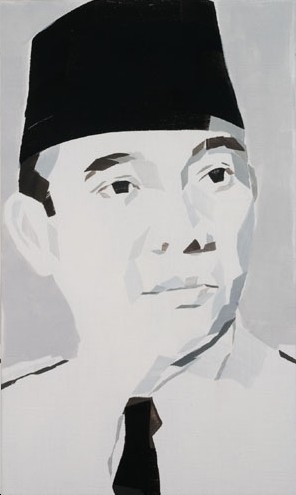Marjolein Rothman
18 Oct - 06 Dec 2008
MARJOLEIN ROTHMAN
"Our Land"
Motive Gallery is pleased to present 'Our Land', a solo exhibition of new works by 2004 winner of the Dutch Royal Award for Painting (Koninklijke Prijs voor Vrije Schilderkunst), Marjolein Rothman (1974, Eibergen). 'Our Land' will run from the 18th of October through the 6th of December.
Rothman’s fourth solo exhibition 'Our Land' was inspired by a series of anthropological photographs taken during the Dutch colonial rule in Indonesia. Originally the show was planned as an enquiry into the language of colonial photography alone but soon developed into a larger enterprise about the iconography of power. Alongside photographs by Dutch pioneers, Rothman went on to base some of her new works on official portraits of members of the Dutch royal house and the Japanese emperor Hirohito and his wife. In this manner, she sought to broaden her previous enquiry into the way collective identities crystallize around specific representations that had given way to her two previous solo exhibitions, 'Iconography I' (2006) and 'Iconography II' (2007), in which she looked into the visual vocabulary of sanctity.
'Our Land' borrows its name from one of the works featured in the exhibition. The painting 'Our Land' presents a group-portrait of half-naked Indonesian women in their traditional sarongs directly looking into the camera. These result both daring and defenceless; monumental and disquietingly seductive in their native attires. As a counter-point to this portrayal of colonial subjects, the large-scale canvas titled History displays a group-portrait of late nineteenth century European women seen from the back on the seashore. History bespeaks Rothman’s admiration for the art of the Romantics and builds in a tension between an alluring composition and its possible critical reading in terms of the facelessness of power. On the other hand, when authority does get a face, in the case of works such as 'Wanna Be King' and 'The Queen' (portraits of prince Hendrik and queen Wilhelmina respectively), it is to undermine its sovereignty and present us with a row of pawns in a chess game of which each of them results to be but a meaningless piece. 'The Queen' is not so much a portrait of the queen Wilhemina as it is of the throne she seems to be literally tied to and which gives symbolic legitimacy to her position. In the same way, the Japanese emperor Hirohito doesn’t so much wear his imposing kimono as he seems to be standing thanks to it. By means of subtly highlighting specific aspects of the composition, Rothman achieves to create highly evocative and multi-layered works that trigger a variety of competing interpretations. Combined with her characteristic fragmented brushwork and a sober colour palette, she turns 'Our Land' into a field of possible views on those who shape and undergo the fates of a history that has become unmasterable.
"Our Land"
Motive Gallery is pleased to present 'Our Land', a solo exhibition of new works by 2004 winner of the Dutch Royal Award for Painting (Koninklijke Prijs voor Vrije Schilderkunst), Marjolein Rothman (1974, Eibergen). 'Our Land' will run from the 18th of October through the 6th of December.
Rothman’s fourth solo exhibition 'Our Land' was inspired by a series of anthropological photographs taken during the Dutch colonial rule in Indonesia. Originally the show was planned as an enquiry into the language of colonial photography alone but soon developed into a larger enterprise about the iconography of power. Alongside photographs by Dutch pioneers, Rothman went on to base some of her new works on official portraits of members of the Dutch royal house and the Japanese emperor Hirohito and his wife. In this manner, she sought to broaden her previous enquiry into the way collective identities crystallize around specific representations that had given way to her two previous solo exhibitions, 'Iconography I' (2006) and 'Iconography II' (2007), in which she looked into the visual vocabulary of sanctity.
'Our Land' borrows its name from one of the works featured in the exhibition. The painting 'Our Land' presents a group-portrait of half-naked Indonesian women in their traditional sarongs directly looking into the camera. These result both daring and defenceless; monumental and disquietingly seductive in their native attires. As a counter-point to this portrayal of colonial subjects, the large-scale canvas titled History displays a group-portrait of late nineteenth century European women seen from the back on the seashore. History bespeaks Rothman’s admiration for the art of the Romantics and builds in a tension between an alluring composition and its possible critical reading in terms of the facelessness of power. On the other hand, when authority does get a face, in the case of works such as 'Wanna Be King' and 'The Queen' (portraits of prince Hendrik and queen Wilhelmina respectively), it is to undermine its sovereignty and present us with a row of pawns in a chess game of which each of them results to be but a meaningless piece. 'The Queen' is not so much a portrait of the queen Wilhemina as it is of the throne she seems to be literally tied to and which gives symbolic legitimacy to her position. In the same way, the Japanese emperor Hirohito doesn’t so much wear his imposing kimono as he seems to be standing thanks to it. By means of subtly highlighting specific aspects of the composition, Rothman achieves to create highly evocative and multi-layered works that trigger a variety of competing interpretations. Combined with her characteristic fragmented brushwork and a sober colour palette, she turns 'Our Land' into a field of possible views on those who shape and undergo the fates of a history that has become unmasterable.

